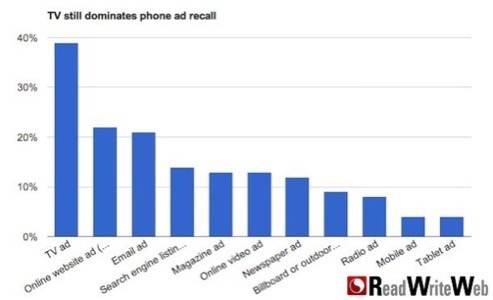
Google has released a new study of how people shop for phones. It’s a helpful category to understand, since a phone purchase is a critical decision for consumers in the digital age. Online information, especially while mobile, is making us pickier. It’s also driving us to buy. But the biggest single influence in a phone purchase is still what happens in the store.

Due Diligence
The biggest new trend demonstrated in this study is that consumers are using the Web to do their homework. Subjects in the study used online tools more than any other resource throughout the process of researching a new phone. Search dominated the process, which is nice news for Google.
The study also found that 60% of research sessions begin two or more weeks before purchase. 41% of consumers considered two different phone models, and 16% considered four or more. More than half of shoppers visited five or more sites while researching.
The one exception to this trend was online retailers. People rely on in-person recommendations from family and friends more than retailer sites. They also go directly to the OEM and carrier websites more than to a retail site like Amazon or Best Buy.

Old-School Ads
Consumers are using the Web to guide their own research process. They aren’t as interested in being interrupted by ads during the process.
Google tried to spin its findings about the way consumers recall ads. Its header is “Online resources leave a lasting impression.” (We’ve changed the title in our version.) But what the chart shows is that phone shoppers are almost twice as likely to remember a TV ad than an online ad. Non-video Web ads, email ads and search listings take the consolation prize, but TV is still the dominant ad vehicle for phone purchases.

There’s another fact that’s painful for Google hiding in plain sight. The two worst-performing ad categories were mobile and tablet ads. The data in this study shouldn’t be applied across the board, but phones are important purchases, and this data shows that consumers just don’t care about mobile ads for them.
Reaching potential customers on mobile is going to bug Google, Facebook and other ad-driven Web businesses until they figure out a new way to engage.
The Moment of Truth
Even though shoppers have gotten comfortable doing their homework online, the decision to buy still happens mostly in person. Google wants to highlight the “influence” of online information on the purchasing process, but its findings show that the in-store experience is still the dominant factor.
While a healthy 25% of phone purchases take place online, and another 24% of purchases are influenced by online research, 45% of cell phone purchases last year were still entirely in-person transactions.

The Web has made roughly half of phone shoppers into more discerning customers, but the rest are still making their buying decisions offline. TV is still the ad medium with the biggest impact. But the message to the industry is clear: People have begun to guide their own shopping decisions and do their research.
Lead photo courtesy of Shutterstock.
Charts 2 and 3 © 2012 ReadWriteWeb

















